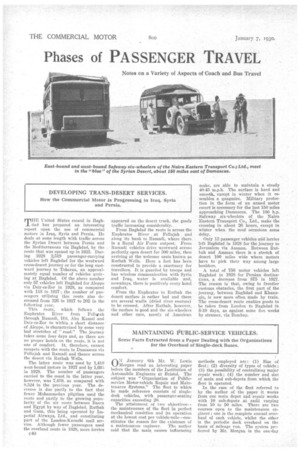Phases of PASSENGER TRAVEL Notes on a Variety of Aspects of Coach and Bus Travel DEVELOPING TRANS-DESERT SERVICES.
Page 62

If you've noticed an error in this article please click here to report it so we can fix it.
How the Commercial Motor fs Progressing in Iraq, Syria and Persia.
T"EUnited States coma] in Baghdad . has prepared an interesting report upon the use of commercial motors in Iraq, Syria and Persia. lie deals at some length with traffic across the Syrian Desert between Persia and the Mediterranean via Baghdad, by the route that was opened up in 1923. During 1928 2,519 passenger-carrying vehicles left Baghdad for the westward cross-desert journey or for the long eastward journey to Teheran, an approximately equal number of vehicles arriving at Baghdad. Of the above number only 57 vehicles left Baghdad for Aleppo via Deir-ez-Zor in 1928, as compared with 118 in 1927; the number of passengers utilizing this route also decreased from 326 in 1927 to 202 in the following year.
This route; whichfollows the Euphrates River from Felheah through Ramadi, Hit, Abu Kama! and Deir-ez-Zor to within a short distance • of Aleppo, is characterized by some very bad stretches of "road." The journey takes some four days and, as there are no proper hotels on the route, it is not one of comfort. it, therefore, cannot compete with the route to Damascus via Fellujah and Ramadi and thence across the desert via Rutbah Wells.
The latter route was used by 1,418 west-bound motors in 1927 and by 1,693 in 1928. The number of passengers carried to the coast in the latter year, however, was 7,419, as compared with 8,524 in the previous year. The decrease is due partly to the fact that fewer Mohammedan pilgrims used the route and partly to the growing popularity of the air route between Basra and Egypt by way of Baghdad, Rutbah and Gaza, this being operated by Imperial Airways, Ltd., and constituting part of the London-Karachi mail service. Although fewer passengers used the overland route in 1928, more lorries
c40 appeared on the desert track, the goods traffic increasing considerably.,
From Baghdad the route is across the Euphrates River , at Fellujah and along its bank to Ramadi, where .there is a Royal Air Force outpost. From Ramadi vehicles drive westward across perfectly open desert for 300 miles, then arriving at the welcome oasis known as Rutbah Wells. Here a fort has been constructed to provide a sanctuary for travellers. It is guarded by troops and has wireless dommunication with Syria and Iraq, water is available and, nowadays, there is positively every hotel comfort.
From the Euphrates to Rutbah the desert surface is rather bad and there are several wadis (dried river courses) to be crossed. After Rutbah, however, the surface is good and the six-wheelers and other cars, mostly of American make, are able to maintain a steady 40-45 m.p.h. The surface is hard and smooth,, except in winter when it resembles a quagmire. Military protection in the form of an armed motor escort is necessary for the last 150 miles approaching Damascus. The 100 h.p. Safeway six-wheelers of the Nairn Eastern Transport Co., Ltd., make the crossing in about 26 hours, except in winter when the mud occasions some delay.
Only 13 passenger vehicles and lorries left Baghdad in 1928 for the journey to Jerusalem via Amman. Between Rutbah and Amman there it a stretch of desert 100 miles wide where motors have to pick their way among large boulders.
A total of 756 motor vehicles left Baghdad in 1928 for Persian destinations, a decrease from 875 in 1927. The reason is that, owing to frontier customs obstacles, the first part of the journey, between Baghdad and Khanaqin, is now more often made by train. The cross-desert route enables goods to be taken from London to Baghdad in 8-10 days, as against some five weeks by steamer, via Bombay6












































































































